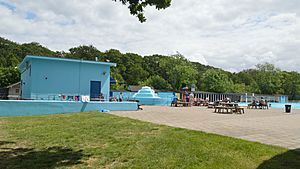Tooting Bec Lido facts for kids
Tooting Bec Lido is a huge outdoor swimming pool in South London. It's the biggest freshwater swimming pool in the United Kingdom! Imagine a pool 100 yards (about 91 meters) long and 33 yards (about 30 meters) wide – that's like three football fields end-to-end!
The Lido is located on Tooting Bec Common, between the areas of Tooting and Streatham. When it was first built, it was hidden behind a big earth mound so you couldn't see it from the common. Today, this mound is covered with trees, making it a peaceful, hidden spot.
With its bright red, yellow, and green changing room doors, the Lido looks amazing. Its colorful design and clear blue water make it a popular place for filming movies and commercials. For example, a boxing scene with Brad Pitt in the movie Snatch was filmed right here!
The London Borough of Wandsworth council looks after and runs the Lido.
Contents
Visiting Tooting Bec Lido
You can visit Tooting Bec Lido during the summer, usually from late May until the end of September. But there's also a special group called the South London Swimming Club (SLSC). They get to use the Lido all year round, even in winter! During winter, the pool is open for them from 7 AM to 2 PM.
If you're a member of the SLSC, you can swim for free when the pool is open to everyone in summer. In 2018, joining the SLSC cost £28, plus another £110 for a yearly pass to the Lido.
The Lido's Long History
Tooting Bec Lido is one of Britain's oldest outdoor pools. It first opened its doors to swimmers on July 28, 1906. Back then, it was called the Tooting Bathing-Lake. A local church leader, Reverend John Hendry Anderson, suggested building the lake. It was a great idea because it also gave jobs to unemployed men in the area. The pool holds a massive one million gallons (about 4,500 cubic meters) of water!
Changes Over Time
When the Lido first opened, boys and girls, men and women, had to swim at separate times. Women and girls could only swim one morning a week! It wasn't until 1931 that "mixed bathing" (where everyone could swim together) was allowed, and even then, only at certain times. At the same time, a fountain-like device called an "aerator" was added. This helps pump water around the pool and keep it clean. One reason for this upgrade was that more women would be swimming, and higher cleanliness was needed.
Five years later, in 1936, a cafe was built, and the changing rooms got proper doors. Around this time, the pool started to be called a "lido" because that word became popular for outdoor pools in England.
Saving the Lido
In the early 1990s, Tooting Bec Lido was almost closed down. The Wandsworth council had to cut back on spending, and they closed another lido in the area. But the SLSC (South London Swimming Club) worked hard to save it! They even took over managing the Lido during the colder months when it wasn't open to the public.
Since 1999, the Wandsworth council has put money into making the Lido even better.
One big change was moving the public entrance to the northern, shallow end of the pool. This meant that children and people who weren't strong swimmers didn't have to walk past the deep end. At first, the new entrance made the Lido feel less hidden, but new trees planted outside are now making it blend in better.
In 2005, the pool was drained and repainted to get ready for its 100th birthday celebrations that summer. More major work, like relining the pool and fixing the paving, happened over the winter of 2006–2007. The Lido reopened to SLSC members in March 2007, and they even hosted a "Cold Water Championships" event!
New Pavilion Building
In 2017, a brand new building called the Pavilion was built at the deep end of the pool. This was where the old entrance used to be. The SLSC, SportEngland, and Wandsworth Council all helped pay for it. The Pavilion has a new sports hall that can be used all year round, and better facilities for the lifeguards. Next to the Pavilion, there's also more space for people to relax. The plan is to rebuild the brick arches from the original entrance there as a special memorial.




